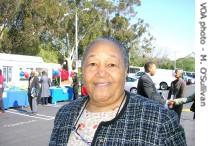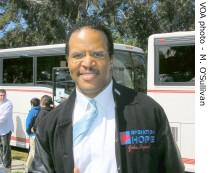2007年VOA标准英语-Los Angeles Leaders See Progress, Challenges 15(在线收听)
Los Angeles
24 April 2007
Fifteen years after riots that killed more than 50 people in Los Angeles, community leaders see progress in easing the racial tensions that sparked the disturbances. Mike O'Sullivan reports, they also see challenges that remain in South Central Los Angeles, where the riots erupted.
The disturbances broke out after a verdict of not guilty in the trial of four police officers accused of beating black motorist Rodney King. In South Central Los Angeles, the jury decision sparked outrage and led to an outbreak of burnings, looting and violence.
Civil rights activist Jack Mack, now the president of the of the city's civilian police commission, says investment in the neighborhood by sports star Magic Johnson and other business executives has made a difference. "No question about it. As you look around and as I reflect back, there was a lot of hopelessness, but today, 15 years later, as we look around, we can see some obvious signs of progress. There is the Magic Johnson theater, which employs over 300 young people and shows first-run movies in this community," he said.
He says that 15 years ago, there were almost no supermarkets in this neighborhood. Today, they are everywhere. He says churches, civic groups, and community organizations have spurred development of new housing and businesses. "That's the good news. On the other hand, we have remaining challenges. Too many of our young people are not being properly educated by the Los Angeles Unified School District. Too many are dropping out without positive alternatives. Gang violence is a serious problem that we must get a handle on."
 |
| Alice Harris |
"And we said, we are not going to move, we are going to improve. We are going to bring the young people together and not let them fight and kill one another. So that was the birth of the Parents of Watts, to bring the Afro-American and Hispanic families together, children together, so they wouldn't kill one another," she said.
Alice has lived through two sets of riots in this section of the city, in 1965 and then in 1992. She recalls the time when there was no hospital in South Central Los Angeles, and taxicabs refused to enter the neighborhood. She says that has changed, however. "You can get a cab in Watts now. We have a hospital. So you see, we might not be what we out to be, but we sure are not what we used to be," she said.
A bus tour of South Los Angeles for business people, bankers, local officials and journalists highlighted some of the changes. The tour was led by Andrew Young, a former U.S. ambassador to the United Nations, and John Hope Bryant, founder of Operation Hope, an organization devoted to teaching financial literacy in the inner city.
 |
| John Hope Bryant |
The infusion of cash has helped, and community leaders say South Central Los Angeles has changed in another way since 1992. They say problems remain, from gang violence to unemployment, but the despair that pervaded this neighborhood is giving way to a sense of hope. They say the neighborhood may not be back, but it is better.